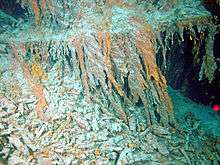Rusticle
A rusticle is a formation of rust similar to an icicle or stalactite in appearance that occurs deep underwater when wrought iron oxidizes. They may be familiar from underwater photographs of shipwrecks, such as the RMS Titanic and the German battleship Bismarck. They have also been found in the #3 turret, 8-inch gun turret on the stern remains in place of the USS Indianapolis.[1] Rusticles are created by microbes that consume iron.[2]

The word rusticle is a portmanteau of the words rust and icicle and was coined by Robert Ballard, who first observed them on the wreck of the Titanic in 1986.[3] Rusticles on the Titanic were the first investigated in 1996 by Roy Cullimore, based at the University of Regina in Canada. A previously unknown species of bacteria living inside the Titanic's rusticles called Halomonas titanicae was discovered in 2010 by Henrietta Mann.
Rusticles can form on any submerged steel object and have been seen on other subsea structures such as mooring chains[4] and subsea equipment. They form more rapidly in warmer climates and can form in water with little to no dissolved oxygen.[4]
Composition
The rusticle consists of up to 35% iron compounds including iron oxides, iron carbonates and iron hydroxides. The remainder of the structure is actually a complex community of symbiotic or mutualistic microbes including bacteria Halomonas titanicae[3] and fungi that use the rusting metal as a source of food, causing microbial corrosion and collectively producing the mineral compounds that form the rusticle as waste products.
Structure
Structurally, rusticles contain channels to allow water to flow through, and they seem to be built up in a ring structure similar to the growth rings of a tree. They are very delicate and can easily disintegrate into fine powder on even the slightest touch.
Colors
The outer surface of a rusticle is smooth red in appearance from the iron (III) oxide, while the core is bright orange due to the presence of crystals of goethite (a hydrated iron oxide).
References
- "USS Indianapolis: The Final Chapter | PBS". USS Indianapolis: The Final Chapter | PBS. Retrieved 7 Jan 2019.
- Cullimore, Dr. Roy; Lori Johnston (February 27, 2012). "Rusticles Thrive on the Titanic". National Oceanic and Atmospheric Administration.
- "New species of bacteria found in Titanic 'rusticles'". BBC News. 6 December 2010. Retrieved 1 March 2012.
- Microbiologically influenced corrosion of Gulf of Mexico mooring chain at 6,000 feet depths